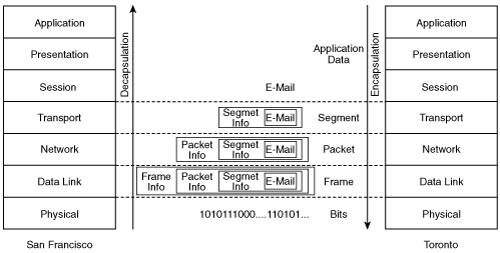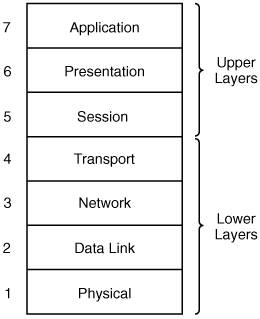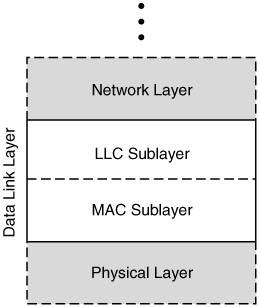LANs and WANs
Protocols and the OSI ModelConsider that you are in Toronto and you want to send an e-mail to your friend in San Francisco. Successfully sending and receiving e-mail involves doing many things, including the following:
The following sections introduce the model that specifies all of these functions so that the system as a whole can work correctly. The OSI ModelThe International Organization for Standardization (ISO) standards committee created a list of all the network functions required for sending data (such as an e-mail) and divided them into seven categories. These categories are collectively known as the OSI 7-layer model, which was released in 1984. The model is illustrated in Figure B-1no network book would be complete without a section on the OSI model. Figure B-1. Each of the Seven Layers of the OSI Model Represents Functions Required for Communication Note You might also have heard people talk about OSI Layers 8 and 9. While they are not official, Layer 8 is commonly known as the political layer, and Layer 9 is the religious layer. These light-heartedly represent all the other issues you might encounter in an IT project. Key Point The OSI model represents everything that must happen to send data. The important thing to remember is that the OSI model does not specify how these things are to be done, just what needs to be done. Different protocols can implement these functions differently. For example, the open-standard Internet Protocol (IP) and Novell's Internetwork Packet Exchange (IPX) Protocol are different implementations of the network layer. As also shown in Figure B-1, the seven layers can be thought of in two groups: the upper layers and the lower layers. The term upper layers often refers to Layers 5 through 7, and the term lower layers often refers to Layers 1 through 4, although this terminology is relative. The term upper layer also refers to any layer above another layer. The upper layers are concerned with application issuesfor example, the interface to the user and the format of the data. The lower layers are concerned with transport issuesfor example, how the data traverses the network and the physical characteristics of that network. ProtocolsA protocol is a set of rules. The OSI model provides a framework for the communication protocols used between computers. Just as we need rules of the roadfor example, so that we know that a red light means stop and a green light means gocomputers also need to agree on a set of rules to successfully communicate. Two computers must use the same protocol to communicate. Computers that try to use different protocols would be like speaking Italian to someone who only understands Englishit would not work. Many different networking protocols are in use, in a variety of categories. For example, LAN and WAN protocols (at the lower three OSI layers) specify how communication is accomplished across various media types, routed protocols (at Layer 3) specify the format of and how data is carried throughout a network, and routing protocols (also at Layer 3) specify how routers communicate to indicate the best paths through the network. Key Point Many protocol suites define various protocols that correspond to the functions defined in the seven OSI layers, including routed protocols, a selection of routing protocols, applications, and so forth. Protocol suites are also known as protocol stacks. The most widely used network protocol suite is the TCP/IP suite, named after two of the protocols within the suite; this protocol suite is used in the Internet. Novell's Netware is another example of a protocol suite. Key Point The OSI protocol suite is another suite. Although the OSI protocol suite uses the same names for its seven layers as the OSI 7-layer model does, the two OSI items are differentone is a protocol suite and the other is the model that all the protocol suites are based on. The OSI LayersThe following sections briefly describe each of the seven layers of the OSI model, starting at the lowest layer. Physical Layer (Layer 1)The OSI physical layer defines specifications such as the electrical and mechanical conditions that are necessary for activating, maintaining, and deactivating the physical link between devices. Specifications include voltage levels, maximum cable lengths, connector types, and maximum data rates. The physical layer is concerned with the binary transmission of data. This binary data is represented as bits (which is short for binary digits). A bit has a single binary value, either 0 or 1. Note Appendix C, "Decimal-Binary Conversion," provides information on binary numbers and explains how to convert between decimal and binary formats (and vice versa). Data Link Layer (Layer 2)Layer 2, the data link layer, defines the format of data that is to be transmitted across the physical network and indicates how the physical media is accessed, including physical addressing, error handling, and flow control. The data link layer sends frames of data; different media have different types of frames. Key Point A frame is a defined set of data that includes addressing and control information and is transmitted between network devices. A frame can contain a header field (in front of the data) and/or a trailer field (after the data); these two fields are said to frame the data. For LANs, the Institute of Electrical and Electronics Engineers (IEEE) split Layer 2 into two sublayers: Logical Link Control (LLC) and Media Access Control (MAC), as illustrated in Figure B-2. Figure B-2. For LANs, the Data Link Layer Is Divided into the LLC and MAC Sublayers The LLC sublayer (defined by the IEEE 802.2 specification) allows multiple network layer (Layer 3) protocols to communicate over the same physical data link, by allowing the Layer 3 protocol to be specified in the LLC portion of the frame. The MAC sublayer specifies the physical MAC address that uniquely identifies a device on a network. Each frame that is sent out specifies a destination MAC address; only the device with that MAC address should receive and process the frame. Network Layer (Layer 3)The network layer is responsible for routing, which allows data to be properly forwarded across a logical internetwork (consisting of multiple physical networks). Logical network addresses (versus physical MAC addresses) are specified at Layer 3. Layer 3 protocols include routed and routing protocols. The routing protocols determine the best path that should be used to forward the routed data through the internetwork to its destination. The network layer sends datagrams (or packets); different routed protocols have different types of datagrams. Key Point A datagram is a defined set of data that includes addressing and control information and is routed between the source and the destination of the data. A datagram might contain a header field (in front of the data) and/or a trailer field (after the data). If a datagram needs to be sent across a network that can only handle a certain amount of data at a time, the datagram can be fragmented into multiple packets and then reassembled at the destination. Thus, a datagram is a unit of data, while a packet is what physically goes on the network. If no fragmentation is required, a packet is a datagram; the two terms are often used interchangeably. Transport Layer (Layer 4)Layer 4, the transport layer, is concerned with end-to-end connections between the source and the destination. The transport layer provides network services to the upper layers, including connection-oriented and connectionless transport, multiplexing, and error checking and recovery. Connection-oriented reliable transport establishes a logical connection and uses sequence numbers to ensure that all data is received at the destination. Connectionless unreliable transport just sends the data and relies on upper-layer error detection mechanisms to report and correct problems. Reliable transport has more overhead than unreliable transport, just as using a courier company costs more than using regular mail to deliver your letters. Note The term unreliable as used here does not mean that the network isn't functioning properly or that the data won't be delivered. Rather, it means that the protocol will not check to see if the data was delivered intact; this function must be done by a higher level protocol, or the end-user. Multiplexing allows many applications to use the same physical connection. For example, numbers identify different applications, and data is then tagged with the number that corresponds to the application from which it came. Both sides of the connection are then able to interpret the data in the same way. The transport layer sends segments. Key Point A segment is a defined set of data that includes control information and is sent between the transport layers of the sender and receiver of the data. A segment can contain a header field (in front of the data) and/or a trailer field (after the data). Upper Layers (Layers 5 through 7)From the lower layers' perspective, the three upper layers represent the data that must be transmitted from the source to the destination; the network typically does not know nor care about the contents of these layers. For completeness, the following briefly describes the functions of these layers:
Key Point The OSI application layer is not the application itself; rather, the OSI application layer provides the communication services to the application. For example, your e-mail application might use two OSI application layer protocolsSimple Mail Transfer Protocol (SMTP) and Post Office Protocol version 3 (POP3)to send and retrieve e-mail messages. Communication Among OSI LayersThis section describes how communication among the seven OSI layers is accomplished. When you send an e-mail from Toronto to your friend in San Francisco, you can think of your e-mail application sending a message to the e-mail application on your friend's computer. In OSI model terms, information is exchanged between peer OSI layersthe application layer on your computer is communicating with the application layer on your friend's computer. However, to accomplish this, the e-mail must go through all the other layers on your computer (for example, it must have the correct network layer address, be put in the correct frame type, and so on), then go over the network, and then go back through all the layers on your friend's computer, until it finally arrives at her e-mail application. Control information from each layer is added to the e-mail data before it passes to lower layers; this control information is necessary to allow the data to go through the network properly. Thus, the data at each layer is encapsulated, or wrapped in, the information that's appropriate for that layer, including addressing and error checking. The right side of Figure B-3 illustrates the following encapsulation process:
Figure B-3. Data Is Encapsulated as It Goes Down Through the Layers and Decapsulated as It Goes Up The grouping of data used to exchange information at a particular OSI layer is known as a protocol data unit (PDU). Thus, the PDU at Layer 4 is a segment, at Layer 3 is a packet, and at Layer 2 is a frame. Notice how the overall size of the information increases as the data goes down through the lower layers. When data is received at the other end of the network, this additional information is analyzed and then removed as the data is passed to the higher layers toward the application layer. Thus, the data is decapsulated, or unwrapped; this process is shown on the left side of Figure B-3. Note For simplicity, the example in Figure B-3 shows only two systems, one in San Francisco and one in Toronto, and does not show the details of e-mail protocols or e-mail servers. Later sections in this appendix describe what happens when intermediate devices, such as routers, are encountered between the two systems. At each layer, different protocols are available. For example, the packets sent out by IP are different than those sent out by IPX, because different protocols (rules) must be followed. Both sides of peer layers that are communicating must support the same protocol. |
EAN: 2147483647
Pages: 156

